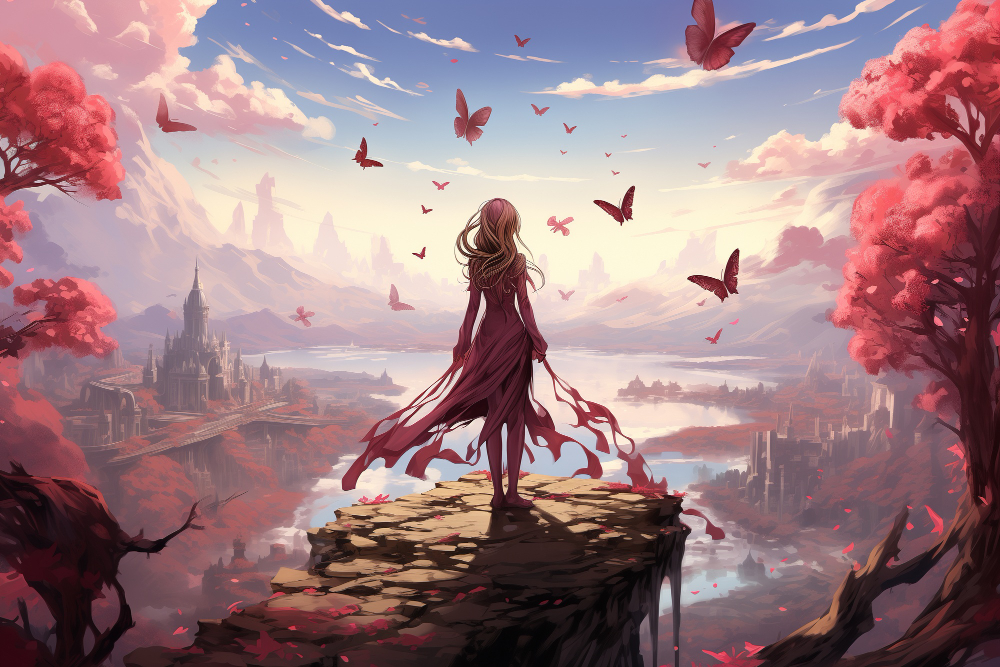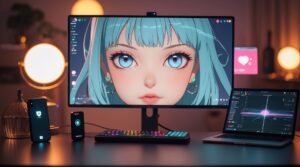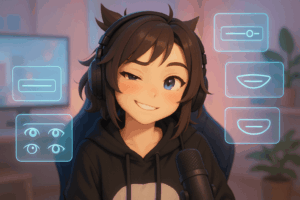Are you planning to create a 3D character? Do you want to know how to make your 3D character stand out? In the modern world of digital art and game development, creating captivating 3D models and character is a necessity to take your imagination to the next level. Every game we play is full of such 3D characters. Whether you are a 3D artist or a game developer, understanding the complexities of 3d character modeling can be an exciting journey to take on.
To help you along your journey to create the best 3D character possible, we are listing some valuable tips and tricks for you. Read on to know more.
What is a 3D Character?
Before jumping to the tips and tricks, let’s take a minute to understand the basics of 3D characters. A 3D character refers to a digital representation of a person, creature, or object created using three-dimensional modeling techniques. Unlike traditional 2D images or drawings, these 3D models and characters have depth, volume, and can be viewed from multiple angles. These 3d models and 3d characters are commonly used in animation and video games, portray lifelike human or other figures within digital environments. They are typically manipulated and animated using specialized software to simulate motion, expression, and interaction.
In gaming, 3D characters have a central role in creating interactive experiences for players. These characters serve as avatars, protagonists, antagonists, and supporting cast members, with their unique personalities and visual designs. From epic adventures to strategic battles, these 3D models of character contribute to gameplay mechanics, storytelling, and player engagement. Game developers leverage advanced character modeling, motion, and artificial intelligence (AI) technologies to infuse the character with lifelike movements, behaviors, and emotion. Whether navigating through vast open worlds or engaging in intense multiplayer battles, players form emotional connections with 3D character, driving deeper engagement and enjoyment in gaming narratives.
Tips and Tricks to Create Characters:
Here are a few essential tips to create a character in 3D:
1. Understand Your Main Goal to Create 3D Character:
Understanding your goal is crucial before you start the process character creation. Whether you’re crafting a character for a game, film, or animation project, defining the intended use and context of your character will significantly influence your design decisions and workflow.
For instance, the character destined for a video game may require optimization for real-time rendering and considerations for gameplay mechanics, while those intended for a cartoon film may prioritize detailing and high-quality rendering for cinematic sequences.
Similarly, the character designed for animation projects may necessitate flexible rigging and expressive features to animate human being and convey human emotions effectively. By clarifying your project and primary goal early on, you can tailor and customize your approach to create character to best suit the specific requirements and constraints of your project, ultimately ensuring that your character fulfill its intended purpose effectively and resonate with your audience.
2. Start with Basic Shapes:
Starting with basic shapes is a fundamental step in the character creation process. By sculpting simple geometric forms, such as spheres, cylinders, and cubes, you establish the foundational structure basic shape and silhouette of your character. This initial approach not only helps you define the overall human figure, shape and proportions but also ensures consistency and balance throughout the design process. By focusing on basic human shapes, you can refine the character’s anatomy and pose.
Additionally, starting with simple forms allows for easier manipulation and experimentation, enabling you to explore various design possibilities with ease. As you progress, you can gradually add complexity and detail, building upon the solid foundation established by the basic shapes.
This methodical approach ensures that the image of your character evolves cohesively and maintains a strong visual presence from the idea and initial stages to the final render.
3. Utilize Low Poly Models:
When creating characters and models for real-time applications such as video games, prioritize creating low poly models to optimize performance without compromising visual quality. Focus on maintaining readability and simplicity in your geometry.
Low poly models offer several advantages beyond just performance optimization. They can contribute to a unique aesthetic, evoking a sense of nostalgia or stylized simplicity that resonates with players. Additionally, their reduced complexity can make them easier to animate and texture, streamlining the development process and allowing for faster iteration. By embracing low poly modeling techniques, developers can not only improve performance but also enhance the overall visual appeal and efficiency of their real-time applications.
4. Embrace Polygon Modeling:
Embracing polygon modeling techniques is essential for creating detailed model of a character. By mastering the manipulation of vertices, edges, and faces, you gain precise control over the shape and structure of your character.
Polygon modeling allows you to sculpt complex features and fine-tune the geometry to achieve the desired look and feel. Whether you’re crafting organic shapes or mechanical components, understanding how to work with polygons is crucial for achieving realistic and visually appealing results.
With high polygon modeling, you have the flexibility to add or remove geometry as needed, allowing for seamless adjustments and refinements throughout the design process. By honing your skills in high polygon modeling, you can efficiently bring your animation character concepts and models to life with precision and accuracy.
5. Explore Concept Art:
Exploring concept art is an integral part of the character creation process. It serves as a blueprint, offering inspiration and guidance as the artist. Whether collaborating with concept artists or creating your own sketches, this step allows the artist and you the ability to flesh out unique character concepts and visualize their appearance and personality.
By delving into this, you the artist can refine your vision and establish a clear direction for your character designs. This collaborative process encourages creativity and ensures that your character is grounded in a cohesive visual narrative.
Additionally, this serves as a valuable reference throughout the modeling and rendering process, helping you stay true to your initial vision while incorporating necessary adjustments and refinements.
6. Master UV Mapping to Create 3D Character:
Mastering UV mapping is a crucial skill for any character artist. This involves unwrapping the three-dimensional surface of a character model into a two-dimensional space, allowing textures to be applied seamlessly. Understanding UV mapping ensures that textures appear correctly on your character model, without any distortion or stretching that can compromise the object’ visual quality.
Properly unwrapping UVs requires attention to detail and an understanding of how different areas of the model will interact with textures. By carefully arranging UVs, you can optimize texture resolution and minimize seams for a polished final result image. Additionally, mastering this allows for greater flexibility when painting textures, enabling you to add intricate features and effects to your character with precision and accuracy.
7. Add Detail Incrementally:
Adding detail to your character models incrementally is a prudent approach that can streamline your workflow and enhance the overall quality of your creations. Rather than attempting to tackle every aspect of your character’s design at once, it’s beneficial to start with broad strokes and gradually refine smaller refinements as you iterate on your design.
By breaking down the process into manageable steps, you can avoid feeling overwhelmed and maintain focus on specific areas of improvement. This methodical approach allows you to evaluate your character’s overall silhouette and proportions before delving into finer features such as wrinkles, textures, and surface imperfections.
Additionally, adding detail incrementally enables you to make informed decisions based on feedback and iteration. As you refine your custom character name’s design, you can assess which details contribute to its visual appeal and narrative, ensuring that each addition serves a purpose and enhances the overall composition.
8. Experiment with Hair and Accessories:
Experimenting with hair and accessories is a creative opportunity to infuse your characters with personality and depth. Whether you’re crafting a majestic mane of hair or designing intricate clothing and accessories, these elements play a significant role in enhancing the overall visual appeal of your characters.
When it comes to hair, explore various techniques to create realistic strands, whether through sculpting, particle systems, or specialized hair simulation software. Experiment with different styles, lengths, and textures to find the perfect look that complements your character’s personality and design. Similarly, clothing and accessories offer endless possibilities for customization, style and expression. From stylish garments to iconic props, these details can help convey your character’s story and create an identity. Consider the fabric, patterns, and embellishments to add depth, texture and realism to your designs.
By embracing experimentation with hair and accessories, you can elevate your cartoon character creations and animations to new heights, adding layers of visual interest and storytelling potential. Don’t be afraid to push the boundaries of creativity and explore unconventional ideas to make your own created characters truly memorable and unique.
9. Leverage Software Tools to Create 3D Character:
Leveraging software tools is essential for streamlining the 3D models and character creation process from scratch and unlocking your creative potential. Familiarize yourself with a range of traditional modeling software, such as Blender, Maya, or 3ds Max, which offer robust features and versatile workflows for character modeling, rigging, and animation.
Additionally, explore specialized software tools like Substance Painter for texturing, which provide powerful capabilities for creating realistic materials and models and adding intricate details to your characters. These software tools offer intuitive interfaces and extensive libraries of materials and brushes, allowing any artist and you to achieve professional-quality textures and models with ease.
By mastering a variety of software tools, you can tailor and customize your character and workflow to suit your specific needs and preferences, whether you’re sculpting organic human shapes, designing intricate clothing, or adding lifelike textures to your characters. Take advantage of online tutorials, forums, and communities to deepen your understanding of each software’s capabilities and learn new techniques to enhance your character creation process.
Ultimately, leveraging software tools empowers you to unleash your creativity and bring your character concepts to life without a steep learning curve. Experiment with different animation software tools and workflows to discover the combination that works best for you, and continue to explore new techniques and technologies to stay at the forefront of animated character creation in the digital age.
10. Consider Commercial Use of 3D Character:
When considering the commercial use of your character, it’s crucial to be mindful of licensing and copyright considerations. Ensure that you have the necessary rights to use third-party assets, including textures, models, and software plugins, in your commercial projects. Respect intellectual property laws by obtaining proper licenses or permissions for any assets you incorporate into your character.
Additionally, if you’re collaborating with other artist or working within a team, clarify ownership and usage rights for the character you create. Establish clear agreements regarding the distribution of royalties, credits, and usage permissions to avoid potential legal disputes in the future.
Before releasing your character for commercial use, conduct thorough research to ensure that they do not infringe upon existing copyrights or trademarks. This includes checking for similarities with other characters in popular media or entertainment franchises.
11. Stay Inspired and Playful:
Character creation is a creative endeavor, so don’t be afraid to experiment and be free to have fun with your character designs. Stay inspired by exploring diverse art styles, references, and cultural influences.
Staying inspired, free and playful is key to fostering creativity and innovation in game character creation and game make. Embrace the freedom to experiment and explore new game ideas, allowing yourself to push the boundaries of traditional game design conventions.
Dive into diverse art styles, references, and cultural influences to fuel your imagination, create, and infuse your character with richness, texture and depth. Draw inspiration from a wide range of sources, including literature, mythology, history, and contemporary art, to create a character that resonate with audiences on multiple levels.
Remember to maintain a sense of curiosity and wonder throughout the creative process. Stay open to new ideas and approaches, and embrace the unexpected twists and turns that arise along the way. By staying inspired and playful, you’ll keep the creative spark alive and produce character designs that captivate and delight audiences.
Conclusion
In conclusion, mastering the art of 3D character creation requires dedication, practice, and a willingness to embrace challenges. By following these tips and tricks, you’ll be well-equipped to create captivating 3d models and character, that captivate audiences and elevate your projects to new heights. Whether you’re crafting fantastical creatures for a serious sci fi-fi adventure or charming cartoon characters for a lighthearted game, the possibilities to create 3D character, are endless. Happy creating!
So, start your character animation journey with 3DAiLY today.




